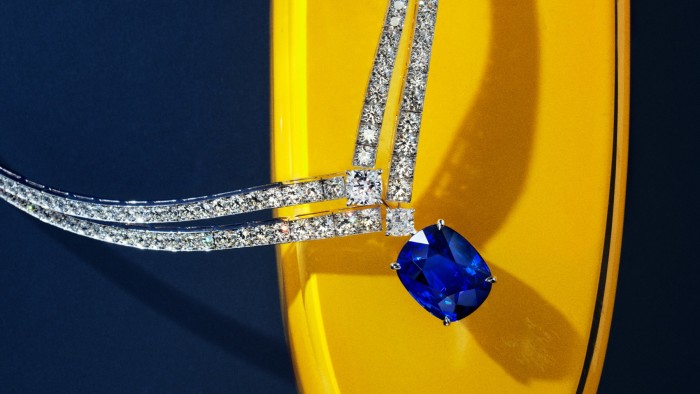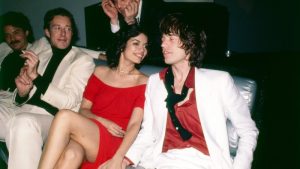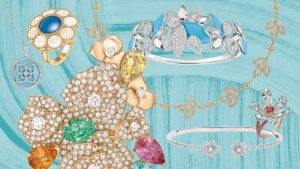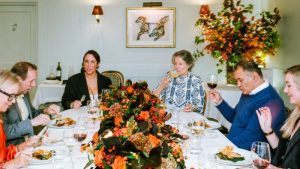Bling it on – jumbo jewels are back

Unlock the Editor’s Digest for free
Roula Khalaf, Editor of the FT, selects her favourite stories in this weekly newsletter.
High jewellery’s “big three” centre stones were traditionally a fine ruby, an impressive emerald or a silky sapphire. These were valuable gems presented as “specimens”, judged on value, rarity and perfection according to strict industry classifications. But the rules have changed. This season’s high jewellery collections proved that the dramatic centre stone can now be an intriguing, unusual, unexpected gem, of intense individuality and spectacularly vibrant or enticingly subtle colour. As for size, as always, bigger is better. But today’s centre stones are just as prized for their individuality and sophistication.


Personality and presence are key to centre-stone selection at Lugano Diamonds, the California-based jeweller whose plush London salon opened earlier this year. A contemporary spiral titanium and diamond necklace, for instance, centres on a colossal 50.76-carat Paraíba tourmaline. Giving off an almost otherworldly glow, the collar is emblematic of CEO and co-founder Moti Ferder’s determination to replace a homogenous house style with a wide array of creative expressions. “While the size and value of a stone are significant, our primary emphasis is on how the jewellery resonates personally with the individual,” says Ferder.
A singular spinel, a coloured sapphire, a dusky diamond, and a massive aquamarine are also grabbing the limelight as unconventional centre stones. Cartier’s Sycamore necklace, for instance, stuns with stacked aquamarines totalling 47.47 carats. In Tiffany & Co’s Blue Book Céleste collection – a reimagining of designer Jean Schlumberger’s favourite cosmic theme – all eyes are on the amethyst of the Shooting Star ring. Tiffany chief gemologist Victoria Wirth Reynolds says the stone “informs the design inspiration and mood that, in its essence, makes it timeless”. Then there is Victoire de Castellane’s brooch created in collaboration with Kim Jones for the Dior Men’s collection: an enormous 58.85-carat aquamarine is encircled by a gem-smothered ribbon, tugged by fluttering birds.


Where is the growing demand for large, exuberantly coloured centre stones coming from? The gem merchant Constantin Wild attributes interest to a growing connoisseurship among top clients. “It’s about individuality, personality, exclusivity,” he says. He agrees that today’s consumers are better informed about coloured gems, a sophisticated choice that depends on nuances of hue and tone as opposed to more easily classified and categorised diamonds. They also appreciate their authentic, natural beauty. Fashions change, too. “In the 1980s, peridot, rubellite and tanzanite were [relatively] affordable, available alternatives to the big three. Today pastel and mud colours like grey spinel or purplish-grey sapphire, pale-pink morganite, or light green or grey hues in tourmaline, offer a new form of elegance.”

Emily Barber, head of important and fine jewels, EMEA, at Sotheby’s, adds: “Sources of traditional coloured gems, for example, rubies from Myanmar or sapphires from Kashmir, are either exhausted or no longer yield fine examples in any great number. Prices have therefore risen exponentially and buyers are looking at alternatives – red spinels are an attractive alternative to rubies, at a lower price point.”
On the evidence of the high jewellery collections, yellow stones are also enjoying a moment in the sun. Louis Vuitton’s Awakened Hands, Awakened Minds collection features a bracelet illuminated by a striking 7.11-carat octagonal-cut yellow sapphire from Sri Lanka. Inspired by 19th-century France, a “phenomenal time of incredible change”, as artistic director for watches and jewellery Francesca Amfitheatrof explains, the yellow sapphire evokes an era of cultural enlightenment. Van Cleef & Arpels’ signet-style Dorestad ring in its Treasure Island collection, is designed around a 13.87-carat emerald-cut yellow sapphire. Embedded in hammered gold and dripping with pink sapphires, spessartite garnets and diamonds, it calls to mind a medieval cache of treasure.


At De Beers, the intense 12.54-carat cushion-cut yellow diamond that sits at the centre of the Protection Masterpiece ring is symbolic of the lion. Unearthed in Botswana, it’s one of four exceptionally rare diamonds labelled “Natural Works of Art” by De Beers, an indication of its singularity. Meanwhile a dreamy 6.21-carat radiant-cut yellow diamond was the centrepiece of a choker in Chopard’s Red Carpet collection, enlivened by a suitably escapist theme of Fairytales.
At Chaumet, centre stones are described as “the soul” of the Parisian maison’s creations. Clients are increasingly requesting exceptional jewels that “ignite the imagination [and] also pay tribute to the treasures of the earth,” says Chaumet CEO Charles Leung. Quality and rarity are high on its list of priorities, with special attention paid to origin. The “most desirable” emeralds are sourced from Colombia, while rubies in “a beautiful intense red with a raspberry accent” hail from Mozambique, and blue and purple sapphires from Madagascar and Sri Lanka. The Joséphine Éclat Floral necklace, for example, features a spectacular 27.08-carat cushion-cut sapphire from Madagascar. Meanwhile Colombian emeralds headline at Bvlgari, where a dazzling 31.67-carat specimen stars in the Green Carpet necklace, and at Graff, where a new bracelet centres on a 6.02-carat kite-cut gemstone.

The same focus on colour was in evidence at Hermès, where Pierre Hardy drew on the colour theory he discovered as an art student for the Les Formes de la Couleur collection. “I like to start with something that is strict, defined and rigorous in structure, then organise the diffraction from it,” says Hardy. For the Colour Vibes ring, he took a crisp 4.01-carat emerald-cut emerald, and enveloped it in ripples of vibrantly hued sapphires, spessartite garnets and baguette diamonds. The effect, according to Hardy, was akin to the wonder generated when a black-and-white movie is colourised – a fitting image for a jewel’s transformative power.
#Bling #jumbo #jewels








